Sweating the Small Stuff—Are You Sure You Are Using Your Pipette Properly?
Most analytical chemists believe their pipetting technique is infallible, but few of us are actually following all of the recommendations within the relevant guidance. Incognito investigates good pipetting practice and busts some of the urban myths behind what is probably the most widely used analytical tool.
At the heart of most analytical techniques is sample preparation. At the heart of most sample preparation is dilution and quantitative transfer of liquids. In many cases, these operations are performed using air displacement or positive displacement pipettes, which I’d like to focus on in this Incognito column.
You may ask why? Given that these pipettes are used daily by most practicing analytical chemists, surely we know everything there is to know? Well, the trouble is I believe many of us think we know all there is to know and that our pipetting technique is infallible. I guess I was in the same camp until recently, when a laboratory investigation caused me to question just how good I was. Had I been taught properly in the first instance? Had I become lazy over the years? Did I rely too much on the urban myths that had been relayed to me over my career about what’s good and what’s not? It turns out the answer to these questions—in my case—was a pretty emphatic “yes”. So where do I turn for a primary reference to improve my practice and bust some of these myths?
After a little searching, I came across what I believe to be two excellent reference documents on pipettes and the art of pipetting: Internal Standard (ISO) 8655-2 Piston-Operated Volumetric Apparatus–Piston Pipettes (1) and (ISO) 8655-6 Piston-Operated Volumetric Apparatus–Gravimetric Methods for the Determination of Measurement Error (2). Much of the “reference” information contained within this article, and the answers to many of my lingering questions, are drawn from these references. I have also used information and guides from several of the leading pipette manufacturers (3,4) and a useful guide from the National Physical Laboratory (UK) (5). These documents also contain a host of useful information and technical reference tables that are not directly mentioned here but which every analytical chemist should be aware of.
For those readers who may be a little sceptical as to how much difference pipetting errors can contribute to the overall uncertainty budget of an analytical measurement, I’ll be highlighting the impact of poor pipetting technique as we progress the discussion.
So, let’s start with choosing the correct pipette for the job. On the basis that I see far more air displacement pipettes in laboratories than positive displacement pipettes, lets look at the working principles of both, and the circumstances under which they should be used.
In short, an air displacement pipette has a layer of air between the head of the piston and the liquid within the pipette tip. Air pressure is used to force liquid from the tip. Positive displacement pipettes have an integral piston within the disposable tip and the piston is in contact with the liquid being dispensed. Both types are shown schematically in Figure 1.
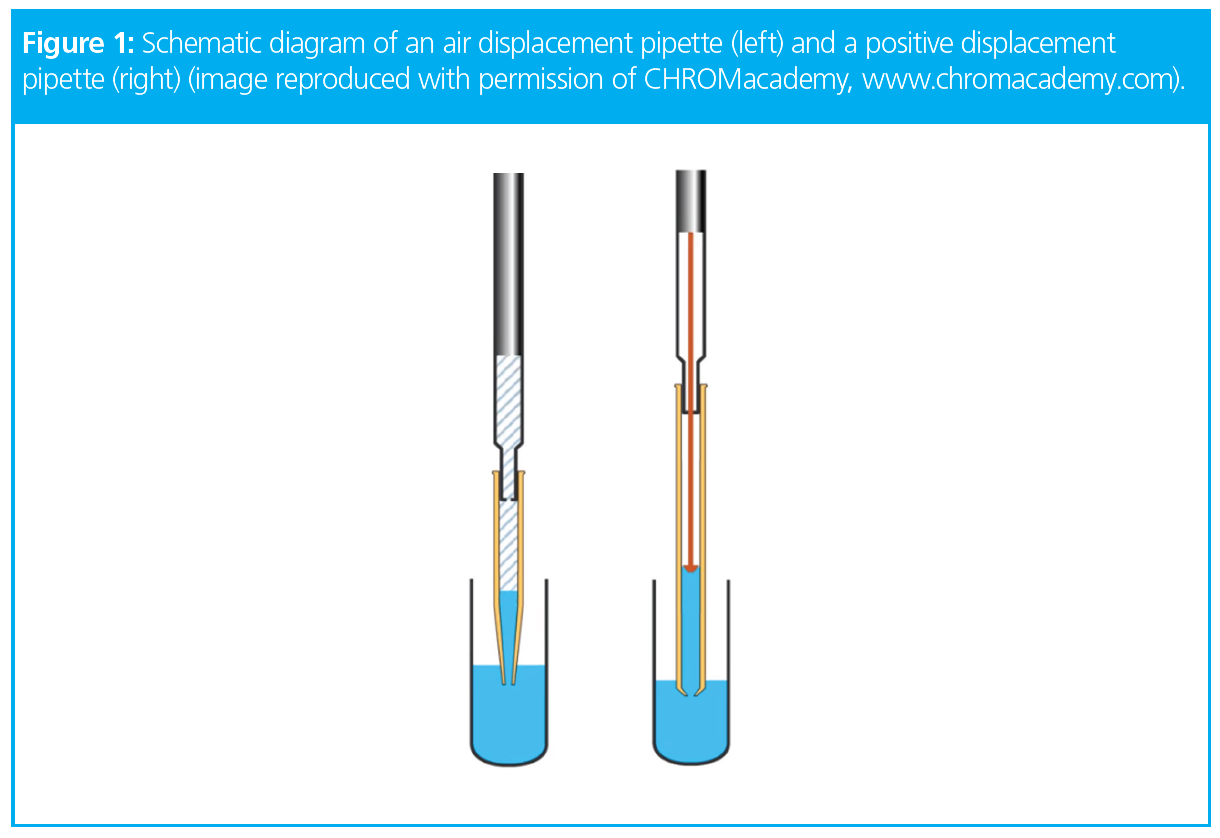
The manufacturers recommendations align well when considering which type of pipette to use for which sample type:
- Aqueous and biological samples—air displacement pipette
- Viscous, volatile, or corrosive samples—positive displacement pipette
I wonder if, like me, you have been using an air displacement pipette for relatively volatile organic solvents for years?
The choice of pipette tips and correct installation also brought further surprises. First, only manufacturers tips are recommended, and all manufacturers recommend that if alternative brands are used, then a “test” for accuracy and precision of the dispensed volume should be undertaken, as per ISO 8655‑6, which I will cover in more detail later. I was a little sceptical when I read this—is it just a way of locking us into the manufacturer’s consumable? This may be true, but reference 1 does contain a detailed specification for pipette tips and the information that needs to be provided to the user—I’d recommend that anyone purchasing pipette tips reads this.
On pipette tip installation, for air displacement pipettes, rather than pressing the pipette shaft firmly down on to the tip (known as “hammering”) or pressing the tip straight onto the shaft, it is recommended that a slight twisting motion is used to create a good seal. Whilst loose tips may be purchased, it is recommended the tip is always fitted with the piston held vertically to ensure a good seal and so the tip is level on the pipette shaft, and it strikes me that tips supplied in racks are a more convenient (although more costly) option. For positive displacement pipettes, the above guidance should be followed, but once the tip is installed onto the shaft the tip should be lifted out of the rack and the piston lowered until a “click” is heard as the piston locks into the pipette body and the plunger should then be pressed to the first stop position. Figure 2 contains an explanation of the various plunger positions of a typical piston pipette.
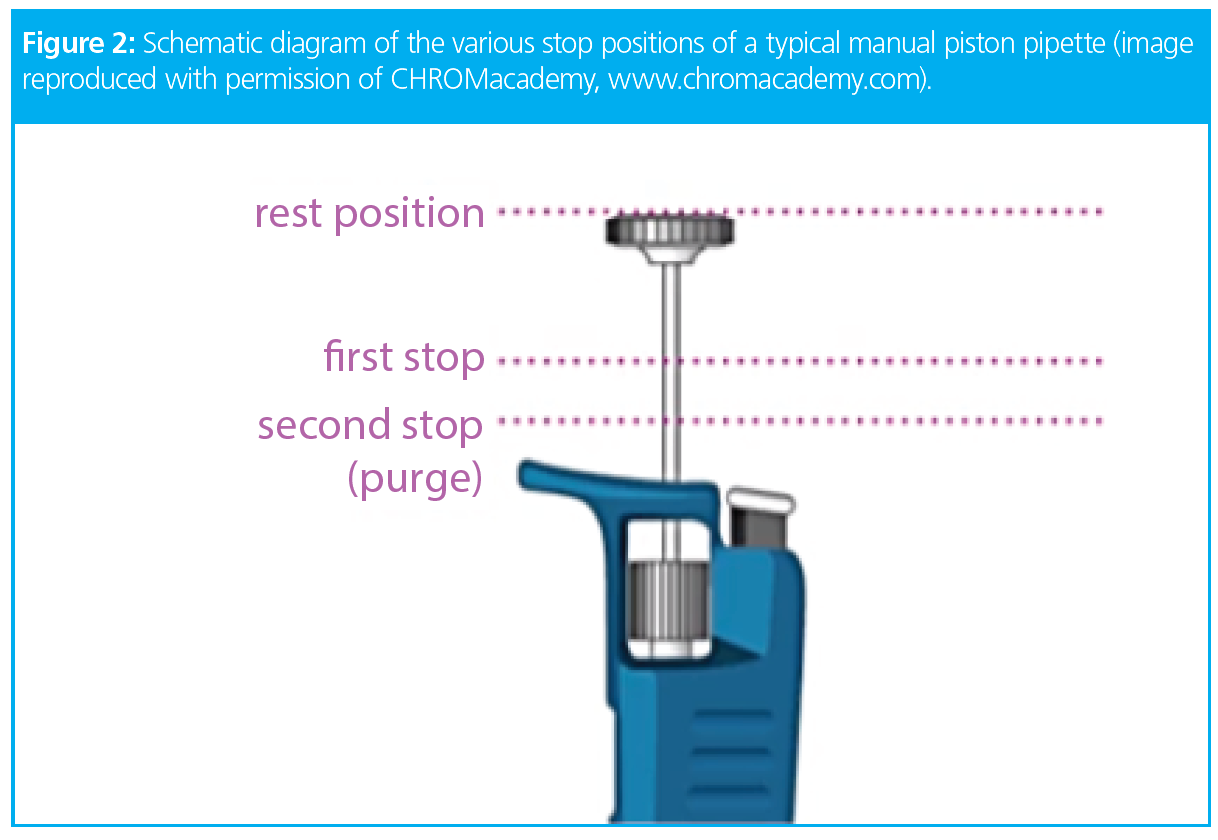
Most manufacturers assert the importance of not cleaning and re-using pipette tips.
So now we have chosen the correct pipette type and correctly installed the tip, lets look systematically at the guidance for correct usage; note that I’ve added some notes and interpretation where this brings further clarity. I’ll deal separately with air displacement and positive displacements.
Air Displacement Pipette—Forward Pipetting Mode
a) Set Correct Volume (Variable Volume Pipettes): When using a variable volume pipette, some manufacturers recommend the volume is “dialled” using a clockwise motion. That is, when reducing the volume, slowly move the volume setting dial to the required volume, but when increasing the volume, overshoot the required setting by 1/3 of a turn and then reduce the volume to the desired setting. In this way, the desired volume is always reached using a clockwise motion. Always hold the volume setting at eye level to avoid parallax error.
b) Aspirate an Aliquot of the Liquid to be Dispensed, Allow to Equilibrate, and Dispense to Waste: Holding the pipette vertically, smoothly depress the plunger to the first stop position, immerse the tip of the pipette into the liquid to be aspirated to the depth recommended in Table 1, and aspirate the liquid by smoothly and steadily raising the plunger to the rest position. Notes: Jerky or rapid plunger movement will increase the error in the amounts of liquid aspirated or dispensed.If the tip is immersed too deeply, the increased hydrostatic pressure may cause too much liquid to be aspirated or liquid droplets to adhere to the outside of the pipette tip, which may be transferred to the receiving vessel. If the tip is not immersed deeply enough, then vortexing may occur or the liquid level may fall below the tip before reaching the top of the filling stroke—in both cases too little liquid will be aspirated.

Wait two seconds for the aspirated liquid to move up into the tip and to equilibrate the temperature and pressure of the headspace air above the liquid.Notes: This step is particularly important in air displacement pipettes due to the changing compressibility of the headspace air above the aspirated liquid as a result of temperature and vapour pressure changes. It is also worthy of note that the aspiration of the liquid into the vacuum space created when the plunger is released from the first stop to the rest position is governed by the ambient atmospheric pressure, which may need to be compensated for if significantly different from those at which the pipette is calibrated (typically 20 ºC, 50% relative humidity, and barometric pressure of 101 kPa).
This first aliquot should then be discarded to waste, or if the liquid is to be retained, return to the original container. Note that any contaminants present on the inside surface of the pipette tip may also be returned to the sample or reagent.
This tip wetting step can significantly reduce the error associated with pipetting and acts to reduce any interfacial effects between the liquid being aspirated and the inside surface of the pipette tip. With certain liquid types, or during pipette calibration or testing, some manufacturers and standards bodies call for up to five pre-equilibration and wetting step repeats prior to the first “real” aspiration into a new tip or when volume changes are made to adjustable pipettes. This may also be necessary in the normal course of operation when dealing with low viscosity or more volatile liquids, especially where a liquid droplet can be seen hanging from the exit orifice of the pipette tip post aspiration.
c) Repeat Step b) but Retain the Aspirate Liquid in the Pipette Tip: Notes: I have read guidance about, and witnessed first-hand, users wiping any excess liquid from the tip of the pipette prior to dispensing the aspirated liquid. I can see no reference to this practice in the ISO guidance, and, from experience, the use of adsorbent paper to wipe excess liquid from the outside surface of the tip risks contact with the tip orifice, which will draw out a portion of the aspirated liquid through wicking effects. If the pipette tip is immersed to the correct depth within the sample liquid, then there should be no need for wiping of the tip. The exception here will be when extremely viscous liquids are being pipetted (creams, for example), where there may be a requirement to wipe the tip. In this case, great care should be taken to avoid the tip orifice area and a resistant, lint-free cloth should be used.
d) Dispense the Sample: Place the pipette tip gently against the wall of the receiving vessel, just above any liquid that may already be within the vessel, at an angle of between 10 and 45º. Note that this should be achieved by tilting the receiving vessel whilst the pipette remains in the upright orientation.Notes: It is important that the pipette remains in the upright position during dispensing for the reasons outlined previously, as well as to avoid any contamination of the pipette body by aspirated liquid within the tip running up into the pipette body when tilted. The angle of contact between the pipette tip and the wall of the receiving vessel is important to ensure that the liquid is dispensed correctly and to overcome any surface tension effects. One should also note that the ISO guidance recommends a contact angle of between 30 and 45º. It is also important to note that the position of the tip should be above the level of any liquid already within the receiving vessel. If the tip is submerged, then highly inaccurate and poor irreproducible volumes will result. It may be necessary to handle the receiving vessel to create the correct contact angle with the pipette; in this case handling should be kept to a minimum (especially when the vessel is to be weighed) and lint‑free gloves should be worn.
Smoothly depress the plunger to the first stop position. Wait one second and then smoothly depress the plunger to the second stop position to purge any remaining liquid from the pipette tip.Notes: In my opinion, this step is one of the most contentious and misunderstood areas of the pipetting technique. Both the guidance and the pipette manufacturers’ literature recommend the use of the “blow-out” or “purge” feature to dispense all liquid from within the tip, although the ISO guidance does state that this should be done “where applicable”. My question is: When is this step applicable and when is it not? I feel it is best practice to use the purge feature for all pipetting operations and some example data shown later will hopefully justify this comment.
Slowly draw the pipette tip 8–10 mm up or along the vessel wall prior to removal from the vessel and then slowly allow the plunger to return to the rest position and discard the pipette tip.Notes: Again this last step, with particular respect to drawing the pipette tip along the vessel wall, is perhaps an area that is not properly understood. This drawing action is intended to remove any remaining liquid at or around the tip orifice to avoid it being withdrawn by the pipette. Again, some experimentation I have undertaken will be shown later to highlight the effect of not drawing the tip along the pipette wall. It is also important to note that the plunger should not be allowed to move from the second position prior to the contact with the vessel wall being broken (that is, once the tip is removed from the vessel).
Air Displacement Pipette—Reverse Pipetting Mode
Reversed pipetting is particularly useful when handling liquids with high vapour pressure (volatile liquids) or those that are highly viscous. This mode of operation follows all of the guidance that has been discussed above, with some notable exceptions.
a) Prior to aspiration the plunger is depressed to the second stop (purge) position.
b) The liquid is aspirated by allowing the plunger to move from the second stop to the rest position.
c) The liquid is dispensed by pressing the plunger to the first stop position prior to removal.
Notes: The “purge” operation is effectively carried out in the aspiration step rather than the dispensing step. During aspiration, an amount of liquid equal to the amount of air used to purge the tip is aspirated, which compensates for the amount of liquid that remains in the tip after the dispensing step.
I have seen no guidance on whether the tip should be drawn along the inner wall prior to removal in the reversed pipetting mode. I would encourage the reader to undertake their own experiments to decide if this is necessary to achieve the required accuracy when using the reverse pipetting mode.
Positive Displacement Pipette
Much of the important guidance has been discussed above, and points around tip wetting, immersion depth, and wiping are applicable. However, once again, there are some notable exceptions.
a) There is only one stop position on these pipettes, any second stop is actually an eject position for the tip.
b) In the dispense step, the piston is moved to the first stop position. The tip is not touched against the side wall of the receiving vessel and is not drawn along the vessel wall prior to removal.
c) There is no reverse pipetting mode.
Having established best practice, it is interesting to discuss sources of error and tolerance of the pipetting equipment, as again there is much debate and, frankly, nonsense spoken about the accuracy and reproducibility of these volumetric tools.
ISO 8655-2 has a useful table of permissible errors for a variety of pipette types, and I’ve shown typical examples from a range of pipette volumes in Table 2.

These figures are applicable for a series of 10-fold measurements where systematic error is the statistical deviation and random error is the coefficient of variation.
It should be noted that whilst the ISO guidance limits for each nominal volume is applicable to every selectable volume throughout the useful volume range of a variable volume pipette, manufacturers often set tighter specification limits for the nominal volume and between the nominal and lower selected volumes.
We have yet to discuss the required adjustments for non-standard environmental conditions or the buoyancy of the liquid used for these measurements, however, I thought it would be interesting to see how accurate my new-found pipetting technique was, using deionized water that meets the criteria of ISO 3696. The results and analysis are shown in Table 3 for an adjustable air displacement pipette of nominal 100 µL volume. It would appear that my technique is reasonable, and I have achieved a reasonable performance against the ISO requirements for each volume: Incognito systematic error +0.57 µL (100) / +0.36 µL (50) / +0.35 µL (10), ISO systematic error limit ± 1.5 μL (mass to volume Z correction factor insignificant); Incognito random error +0.34 µL (100) / +0.11 µL (50) / +0.43 µL (10), ISO systematic error limit ± 0.6 µL (mass to volume Z correction factor insignificant).
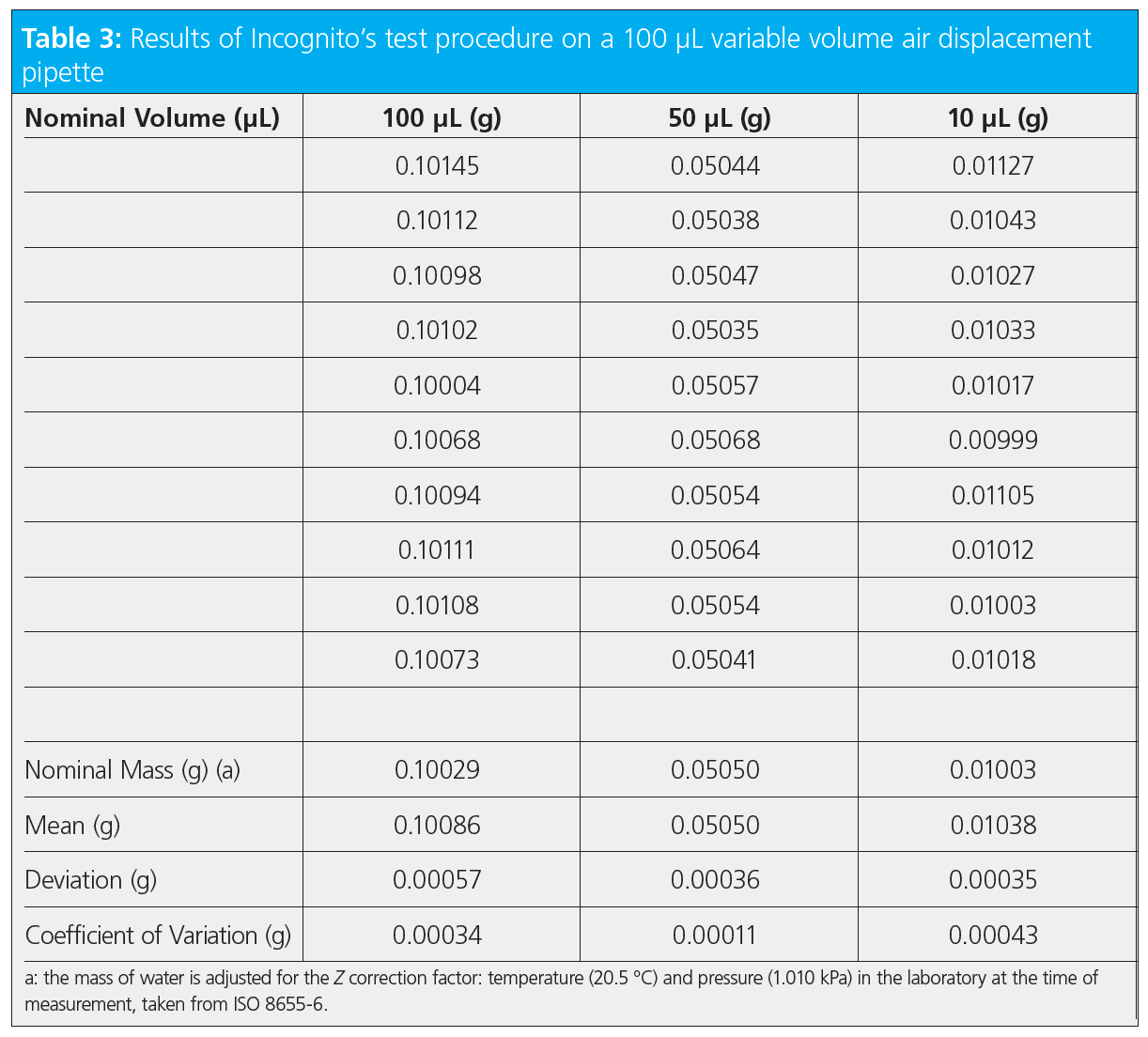
It is worthy of note that the error associated with dispensed volume at 10 µL would not have met the ISO tolerances had I used a pipette of nominal volume 10 µL. This perhaps suggests that one needs to be reasonable about the fraction of the nominal volume that one dispenses, and I know several laboratories who specify that piston pipettes should not be used to dispense volumes less than 50% of the nominal volume for precisely these reasons.
I was also interested in finding out the magnitude of error associated with various aspects of incorrect pipetting technique. The ISO guidance suggests a wide range of estimated errors, some of which are shown in Table 4.
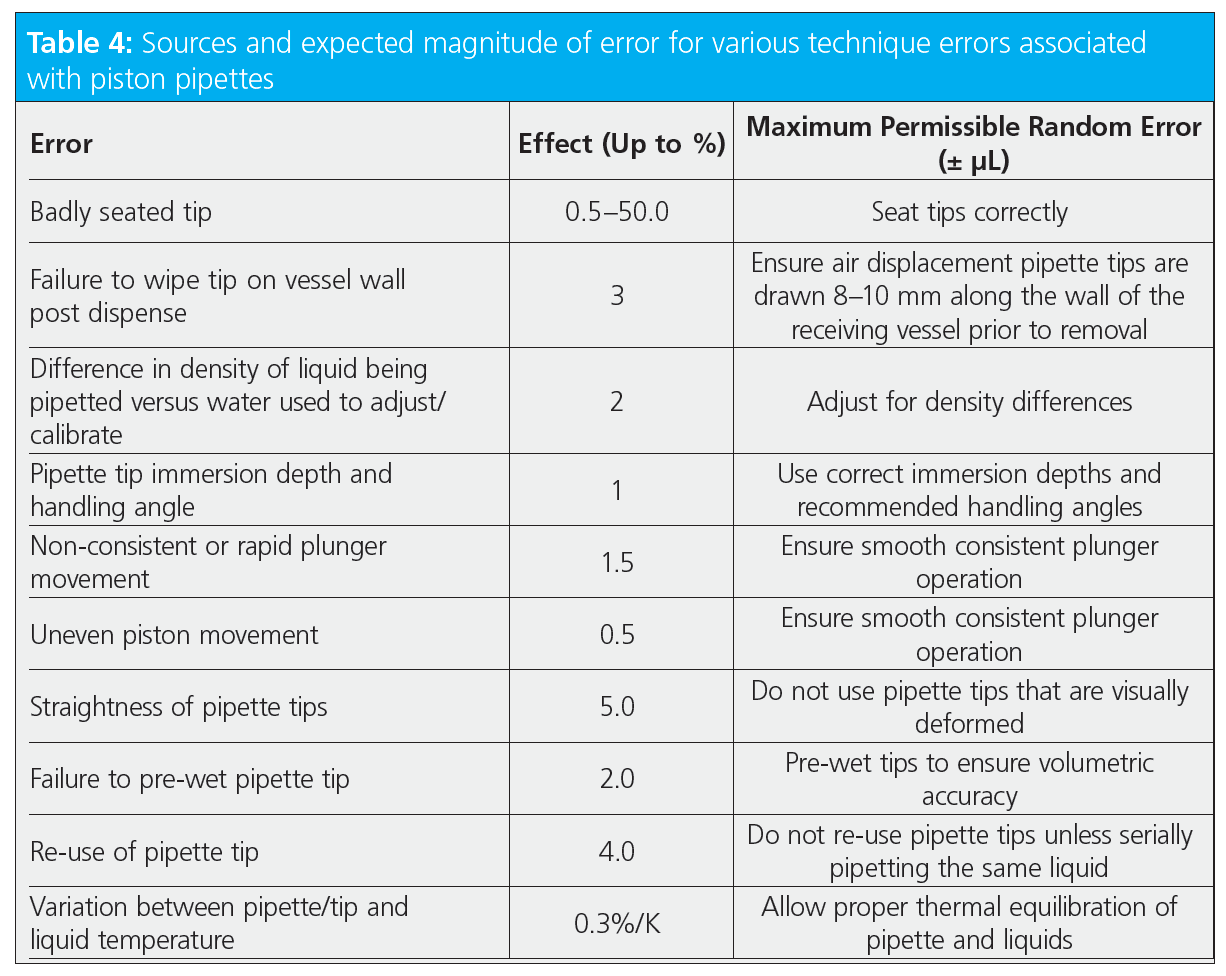
From Table 4 it is obvious that the total cumulative error associated with incorrect pipette technique can be very significant. I investigated the errors associated with some specific aspects of poor technique and these results are shown in Table 5; all results are from 10 replicate measurements of 50 µL of water adjusted for the Z correction factor using a nominal 100 µL pipette.
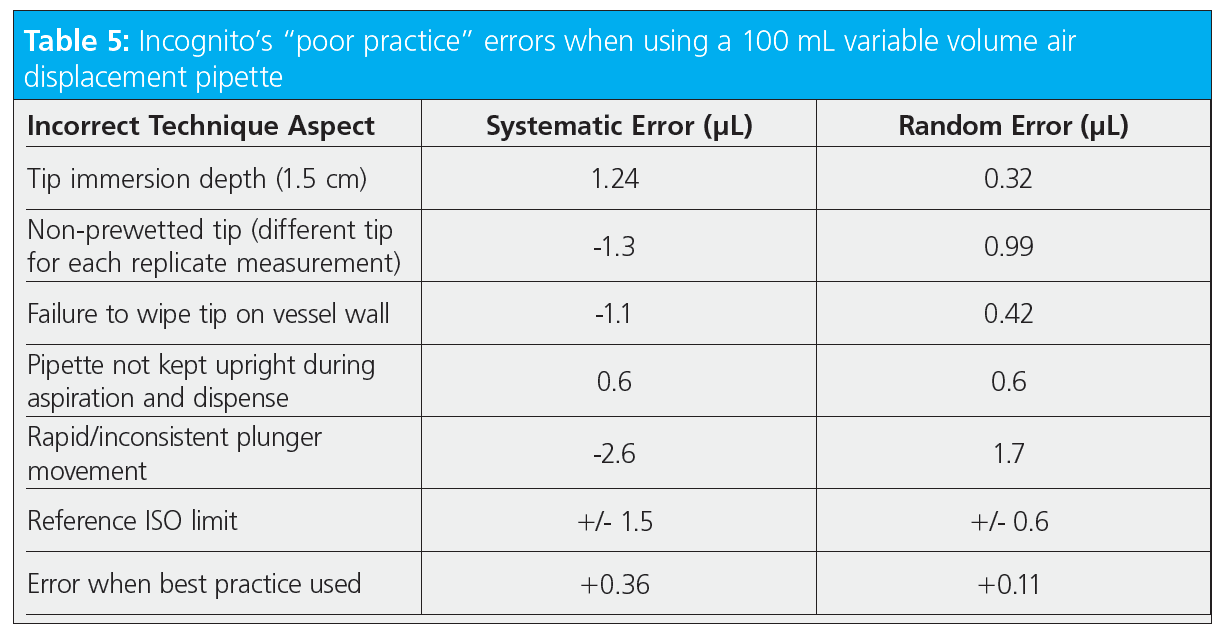
As can be seen from Table 5, several of the poor techniques resulted in out‑of‑specification performance for the dispensed volume limits and all increased the inaccuracies relative to that obtained when using best practice. This is perhaps more salutary when considering that each error was implemented in isolation and that the cumulative error, if several of these poor techniques were combined, could be very considerable.
The reader will notice that I have made adjustments to the “expected” mass of water for these experiments in order to account for temperature and pressure differences between my local environment and the standard conditions used to calibrate (adjust) the pipettes (the Z correction factor). This takes me onto my final topic in this discussion—that of pipette testing and calibration, which I’m often asked about, typically by end users who wish to carry out verification between annual calibration and maintenance.
There are two procedures that are defined in ISO 8655-6:2002: the test procedure for more frequent “checking” of the accuracy and reproducibility of the dispensed volume and a calibration procedure, which is typically carried out annually by the pipette manufacturer. This second procedure can also be carried out by the end user with a little experience and some basic metrology tools. Whilst the full details of the test and calibration procedures are outside the scope of this article, I’d like to note several points that are poorly understood:
- Assessment of systematic and random error should be made on 10 replicate measurements.
- Prior to measurement, a tip should be wetted five times and then discarded to equilibrate the air within the pipette to temperature and relative humidity.
- A new tip should be installed for each of the 10 measurements and each tip should be pre-wetted once before aspirating the required volume.
- For measurements below 50 µL, an assessment of evaporation of the test liquid (water to ISO 3696) should be made by measuring mass loss over the same time period as the 10 test measurements and then dividing this mass loss by 10 and adding the resulting mass to each test weighing.
- A correction for temperature and pressure (the Z correction factor) should be made for the mass of water to account for local conditions versus those for adjustment under standard conditions (tables of water mass at various temperature and pressure values can be found in ISO 8655-6).
- For variable volume pipettes, the assessment should be made at the nominal volume, as well as 50% and 10% of the nominal volume (and all must conform to the ISO 8655-6 limits required for the nominal volume). Note here that the manufacturer may have separate tolerances for the nominal, 50%, and 10% of nominal volumes.
- Systematic error is defined by the variance of the 10 replicate measurements and random error by the coefficient of variation.
I hope that this article acts to stimulate pipette users to examine their own routine and to guide you in best practice as defined by an international standards organization, as well as the pipette manufacturers. I have certainly picked up many tips during the writing of this article and I feel much more confident in my own ability to not only pipette more accurately with piston pipette devices but also to sense when something is not right and to troubleshoot more effectively. To quote Henry Ford, “Anyone who stops learning is old, whether at twenty or eighty. Anyone who keeps learning, stays young”. I feel in the flush of my youth after this salutary learning experience!
References
- ISO 8655-2:2002, Piston-operated volumetric apparatus — Part 2: Piston pipettes (2002).
- ISO 8655-6:2002, Piston-operated volumetric apparatus — Part 6: Gravimetric methods for the determination of measurement error (2002).
- Gilson, Guide to Pipetting, Third Edition (2019).
- Microlit RBO, High Precision Micropipette, Operation Manual.
- J. Blues, D. Bayliss, and M. Buckley, Measurement Good Practice Guide No. 69: The Calibration and Use of Piston Pipettes (National Physical Laboratory, Teddington, United Kingdom, 2004).
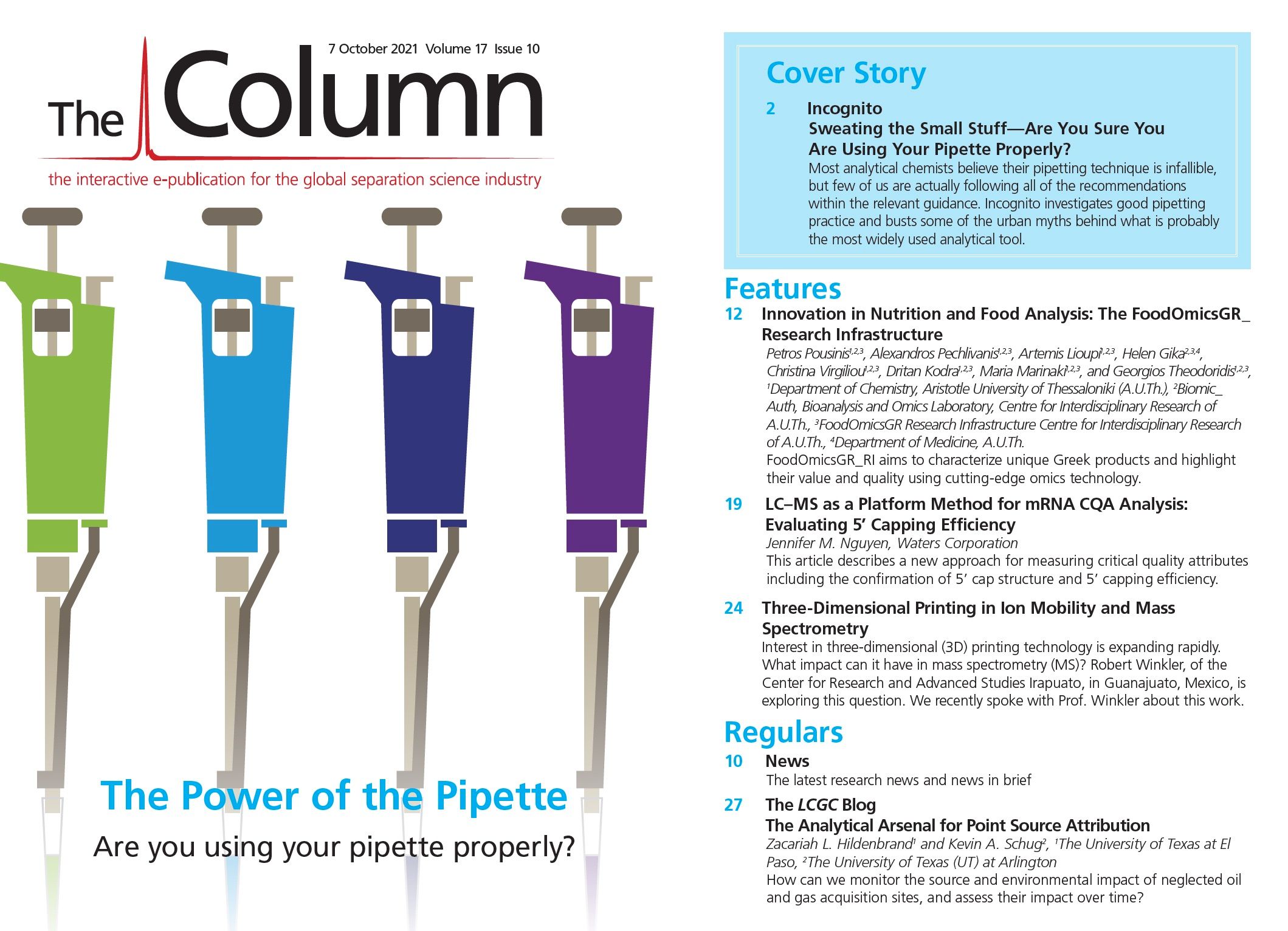
A Final Word from Incognito—The Past, Present, and Future of Chromatography
February 10th 2022After 14 years in print, Incognito’s last article takes a look at what has changed over a career in chromatography, but it predominantly focuses on what the future might hold in terms of theory, technology, and working practices.








